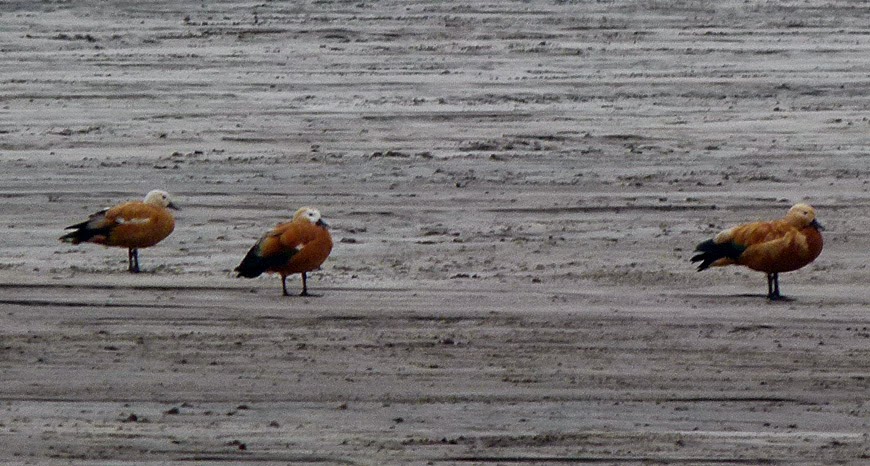Jharli Power Plant, Jhajjar, Haryana
Sunday,
the 14th December 2014
Cloudy
weather, light drizzle and hailstorm in the vicinity, cold.
While
enjoying the cozy warmth of the quilt on such a cold day sipping my herbal tea
with Sunday newspapers, was pushed out of my bed by a phone call from Dr Chetna
Sharma whose enthusiasm for nature-roaming has not staled for the last over one
decade old birding and spiritual rapport we both have shared so far. In a jiffy I was on my toes and wanted to
visit Jhadli Power Plant, about 20 kms from Jhajjar.
Jharli power plant
Great Cormorants
Beginning
was equally wonderful with a couple of hopping House Sparrows and a small party
of Pied Starlings and a few Bank Mynas near the “Himalayan road hugs-soaked
car’, a calf was looking at me with ‘God knows why divinely expressing eyes’.
Phoned Jagat at Jhajjar to get ready for Jhadli. He in turn called Aditya.. both of them were
new to the site I was taking them along.
With Aditya
On way,
saw roadhits – canine and feline; and among
avian dead was a Greater Coucal. Packs of stray dogs almost everywhere.
I have long stopped shedding croco tears on such tragedies.. If I could change
all the drivers and vehicle owners into bird loving ones, things would become a
bit more tolerable for the animals..
Plenty
of ‘silently in prayers doves’ on the transmission wires, a few solitary
Black-shouldered Kites, Indian Rollers on poles, parakeets in swift flights,
egrets, probably cattle, in the one foot tall grassy wheat crops in their sweet
infantile smiling vastness. Mustards patches blooming in yellow – looking a bit
gloomy in cloudy weather, they look wonderfully cheerful in sunny weather.
Grey Heron
Habitat
Waterfowl
Habitat
Took
Jagat and Aditya and drove towards Jhadli; and we were driving along the dirt
road of largish water ponds of the power plant, I guess the total wetland area
must be over 200 acres, though Jagat estimated it over 500 acres; ponds were
teaming with waterfowl. Habitat is wonderfully bird conducive and can be
improved further if our bird-loving experienced birders (not the fund-loving
specialists – God save my country from them) can interact with the management.
I promise to do my part.
Peregrine Falcon
Habitat
Ruddy Shelducks
Ruddy Shelducks
Chair on a foggy cold day
with a kind hearted employee..
Waterfowl
Waterbody
Waterfowl
White-eared Bulbul
Wryneck .. can you spot it?
I
invite my birding fraternity to accompany me in my further forays there.
To be
brief, I am giving a small list of highlights :
Small
Buttonquails – a pair, first a single tiny quail like stuff busy in pecking the
dusty road behind a bush ahead of the car, then the second one joined from
roadside bushy cover. I did not let my birding friends open the window, and
persuaded them to take pix from inside the car. I took time to realize that
they were not barred or yellowlegged, but Small Buttonquails. I took a few pix
too. Attaching.
Ruddy
Shelducks – eight with one Common Shelduck, Eurasian Wigeons, Gadwalls, 8
Mallards, Spot-billed Ducks, Common Teals, 2 Garganeys, no Pintails (?), plenty
of Shovelers, Common Pochards, a few Ferruginous Pochards, Tufted Ducks and
numerous Coots being harassed by three Marsh Harriers, while an Osprey sat
leisurely (do they sit or stand?), two species of kingfishers, a Sirkeer
Malkoha, numerous noisy Alexandrine Parakeets, reed patches hold promise for
crakes, thanks God no water hyacinth so far, a few small waders but no gulls
and no terns.
A
Peregrine Falcon on the pylon – see the pic for what race it is..
Great
Cormorants near their nests, Darters, egrets and herons, at least two Greater
Flamingos and two Spoonbills, a dozen of Painted Storks, Longtailed Shrikes, Bluethroats,
lonely Variable Wheatear, swarm of Plain Martins and Streakthroated Swallows,
White-eared Bulbuls.
Moustached
Warblers in plenty, Common Chiffchaffs – so many of them, Dusky Warblers (not
so sure – but they looked like them)
A
Wryneck perfectly camouflaged in the burnt reeds;
Larks,
pipits, Spanish Sparrows, wagtails, Indian Silverbills.
More
frequent trips are going to produce some rarities too.
Happy
surprise – nosy House Crows seem to be dwindling …





















No comments:
Post a Comment